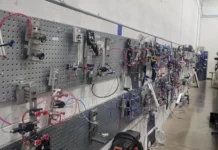by Laurie Harbour-Felax, ASG Renaissance
Any business professional who reads the newspaper, watches the news, or pays attention to industry trends is familiar with lean manufacturing and its great success for companies that dedicate themselves to improvement. Conversely, you can find companies that did not implement lean or continuous improvement strategies and have since either gone out of business or moved overseas. And while it is true that implementation of lean manufacturing can generate huge savings and help companies reduce cost, executives often get confused thinking “lean” is the entire process when, in reality, it is only one tool to become a better company.
In the beginning
Many companies talk about and even begin implementing programs such as Kaizen, Andon, 5S, Standardized Work or 6 Sigma and feel they are taking the necessary steps to become more profitable. Each of these tools is designed to do something different and executives must understand what tool is needed to fix a specific problem or situation. A great example of this can be seen with executives who try to copy the Toyota Production System. They focus on production, because quite frankly, the name leads you to believe that TPS is a production model rather than a total operations improvement model – this is where things quickly begin to fall apart! The truth is that each program is just a tool available in the overall operations improvement toolbox.
In our operations improvement work, we focus on transformation utilizing the Operations Transformation Model (OTM). So how does a company transform itself to survive in this competitive environment? To transform an operation really requires four fundamental steps. Each of these steps has numerous tentacles that are required for success.
I. Leadership’s Admission – it should go without saying but…
The first and probably most important step in transformation is leadership’s admission that change must occur within the company and that a commitment to this change is essential. It’s no different than the alcoholic who can only begin to change once admitting to have a problem. Companies in this country have become, in some instances, arrogant and unaccepting of change. Many of today’s current leaders were fortunate enough to live through the glory days of growing industry and high profits and have been spoiled by this culture. I believe many companies today, because of events of the distant past, have become too complacent and now that things are changing, they are falling behind very quickly.
Operations improvement or lean initiatives never can be successful without leadership commitment from the top. This is a very simple lesson that should probably go without saying, but it is a common mistake made in the majority of facilities failing at their improvement efforts. There are many examples even within companies like GM where business operating systems failed over and over again because leadership support did not exist. In most cases, once the leadership team was on board, admitted to the problem, and committed itself to change, progress happened more rapidly.
II. Setting the State of Improvement
With leadership commitment, the real work begins at developing an improvement / business plan. This is a crucial step in the entire process, yet time and time again, executives fail to plan and inappropriately set off on their improvement journey without a true destination in sight.
Another common mistake is the lack of a benchmark established upfront. Companies often fail to gather the appropriate data to establish baselines, making it literally impossible to measure changes in performance. Data gathering/benchmarking is a difficult but absolutely essential step to any successful improvement effort. Once the data is gathered and improvement goals are created, the leadership team must work on the development of tools and systems to regularly track data to the plan. The tools developed must be used and used consistently to begin to see progress. Leadership and middle management must utilize the tools to drive the business plan. It takes discipline and hard work to stay focused and not stray from the plan. Again, leadership commitment is critical to drive the team to the vision rather than towards the fire that needs extinguishing today.
A great example of this stage is a $100 million stamper in Michigan who struggled for years to improve using every new program read about in a lean book, but without any plan or vision for the company. Employees were confused – never knowing what would be the next “program of the month.” Finally with formal development of a plan, data gathered to baseline the operation, leadership coaching, and discipline to drive the plan, the company made 45 percent productivity improvements, 77 percent improvement to quality, and grew its business 25 percent – all in one year.
III. Return on Investment
Once the improvement focus is engrained in leadership with proper plans and benchmarks, companies can implement tools of good process improvement. New ideas can be used in experimentation, low hanging fruit can be identified, and savings will start to hit the bottom line. This might mean accessing improvement tools such as 5 S, standardized work, or total productive maintenance on the shop floor. But be very aware, it also might mean value stream mapping a payroll system or implementing better vendor management strategies. For example, a service firm in Michigan with over 200 employees struggled with bi-monthly payroll, taking over 55 hours to complete each cycle. Following its vision to improve efficiency at all levels, the company used value stream mapping to document the payroll process and even did time studies at each step. This provided the necessary information to begin process improvements and after two months, the company reduced payroll processing time to five hours per cycle.
The key to transforming is training the workforce on the available tools, when to use them, and how to measure progress. Companies must invest in teaching and coaching their employees on how to recognize improvement opportunities and how to solve problems effectively. Once people have the basic skills and are turned loose, leadership teams are often surprised at the savings that can be found. Leadership has to coach and allow for mistakes in this stage so that the lessons learned can be incorporated and operations transformed.
IV. Don’t Settle for Impact in the First Improvement Attempt
The last part of the process is simple: continuous improvement. Many companies have told me they are as good as they can be and can’t do anything else to improve their operations. But after visiting many of these plants and observing the business, it doesn’t take long to find numerous areas of opportunity. Sometimes small to mid sized firms (and even large companies) get too caught up in the day to day fire fighting to see the real opportunity. And that’s not a pitch for consultants; it is a pitch for continuous improvement. Everyone from leadership to the shop floor must be trained and have a passion for continuous improvement to transform the company.
Even Toyota, who is arguably the manufacturing leader, is constantly challenging the Toyota Production System and improving on its beginning. Leaders need to continually ask the question – how can we do it better? I liken it to a sports team – without the right coach constantly pushing his team to be better, the team wouldn’t be playoff contenders. Companies and employees are no different; to constantly be competitive we have to – daily – push to transform.
So lean manufacturing or operations transformation? Companies that react quickly and implement a total operations transformation are the ones that will be standing when the dust settles. And what is transformation? TRANSFORMATION = LEADERSHIP. It starts there and it ends there.
Laurie Harbour-Felax is president of Harbour-Felax Group. She is a regular presenter at key conferences on the topics of manufacturing and overall business operations improvement and is regularly quoted in local and national publications as an experienced analyst. Harbour-Felax can be reached by calling (248) 414-3866, e-mailing lfelax@harbourfelax.com, or visit www.harbourfelax.com for more information.
Lean Manufacturing Training Programs
The University of Kentucky and the University of Michigan offer formal training programs in lean manufacturing.
University of Kentucky
Sandra Dunn
(859) 257-6262 ext. 214
The University of Kentucky’s Center for Manufacturing in the College of Engineering has a Lean Systems program in place. Working in partnership with Toyota Motor Corporation, the team studies the Toyota Production System to learn why it works as effectively as it does. Based on that research, the university offers training programs at several levels, including Leadership Institutes, Fast Courses, and an intense Boot Camp. Go beyond the surface with courses on Lean Accounting and Human Resources for the Lean Model. Learn how to transform the shop floor. Make sure the entire company is on board by exploring the principles of lean thinking. Learn how to apply lean tools and techniques in a unique hands-on system simulation and learn to champion and firmly plant lean ideals within a business unit. On-site courses and workshops also are available.
University of Michigan
Becky Erskine
(734) 615-5698
The University of Michigan’s Center for Professional Development develops and delivers programs and services that enable engineers, managers, and technical professionals to be more effective, productive, and competitive. Course participants walk away with immediately applicable knowledge and proven tools based on research performed by the world-renowned faculty at the University of Michigan’s College of Engineering. Course offerings include a Lean Manufacturing ten-day certificate program, a Lean Product Process Development five-day certificate program, a Lean Office five-day certificate program, a Lean Logistics ten-day certificate program, and on-line Six Sigma certificate training. Any of the programs offered by the Center for Professional Development can be customized and delivered at a company’s site.




